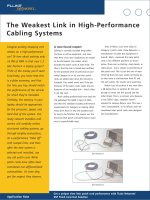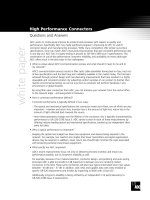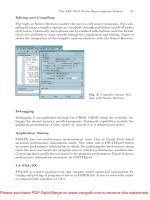high performance organizations
Bạn đang xem bản rút gọn của tài liệu. Xem và tải ngay bản đầy đủ của tài liệu tại đây (1.39 MB, 6 trang )
High Performance
Organizations
It’s no secret that high-performance organizations pay
attention to employee training. Training opportunities do more
than help employees do their jobs better. Employees who are
learning feel valued and are less likely to leave the company. They’re
valued for what they can become and what they can learn, not just
because they’re another cog in the machine.
For more information | />
1
D2563
However, employees have widely differing needs. In 2014, O’Reilly
Media commissioned a study that distinguished between three
different types of learners: beginners who are interested in
fundamentals, practitioners who have already achieved a degree of
proficiency, and high performers. Their needs depend on where they
are in their learning path. Our research found that each type had
specific preferences and needs for how to learn. Someone who is just
starting out has needs that are fundamentally different from an
expert’s. We call this the Performance Stack.
The Performance Stack
H I G H P ER FO R M E R
Learn through non-linear discovery.
Want “speed to idea,” inspiration from many sources, and credible answers for problem-solving.
Need quick access to content with depth, breadth, and quality.
PROFICIENT EMPLOYEES
Learn through both linear instruction (for new skills) and non-linear discovery
(when building on current knowledge).
Want to keep current and solve problems on the fly.
Need high-quality, relevant content, with some structure.
STRUC TUR AL LITER AC Y
NEED THE FUNDAMENTALS
Learn basics through comprehensive, sequential instruction.
Want “speed to understanding” via a formal learning experience
that starts from the beginning and leads to competency
Need the most structure and the least amount of (highly curated) content.
CONTENT
For more information | />
2
D2563
STRUCTURE
Who Learns, and How
The first job of any beginner is to build a framework that allows them to learn
effectively. If you’re learning to program, you’re expected to assimilate a lot of facts
about syntax, data types, control structures, functions, and many other ideas. What
looks most important (is there a semicolon at the end of the line?) is often
unimportant. Good teachers help beginners by shaping facts into a narrative. That
narrative becomes an outline for a book, the syllabus for a course, or the playbook
for a video. It’s central to the beginner’s learning experience. It provides the context
that helps them figure out what’s important.
High performers have different needs. They already know the basics and can fit
facts into a framework that they’ve already built. They can formulate questions,
search for an answer, and get back to work. A lengthy narrative is neither necessary
nor helpful, regardless of the medium.
Practitioners have needs that fall between beginners and high performers. They are
proficient at what they do: they have a conceptual framework that helps them to
assimilate new material, but it might not be well developed. They can learn a new
language without too much difficulty, but they still find a more structured
presentation helpful.
Structural Literacy
For more information | />
3
D2563
The difference between beginners and experts is structural literacy—the intellectual
framework that you build to learn effectively. It allows you to fit small pieces of
knowledge into a larger whole. If you’re a programmer, you’ve experienced this. You
probably learned your first programming language by reading a book or taking a
What’s important about structural literacy isn’t helping
people to attain it. They will do that with traditional training,
and there’s no shortage of resources to help them. It’s
recognizing that, once someone has structural literacy, all the
scaffolding of traditional training gets in the way. The
narrative explanation just isn’t necessary.
Empowering the Leaders
Successful organizations are built around high performers.
Their needs are different, and frequently overlooked. It’s easy
to shortchange the high performers; you’ve seen their
successes, not the hard work that went into achieving those
successes. But it’s critically important to give your best
people the tools they need to perform as effectively as
possible. How do they learn? What questions do they ask?
What are they looking for?
Breadth and Depth
It’s difficult to satisfy the needs of high performers because
their needs are unpredictable. They’re not the people tasked
with building a simple web application. They’re the visionaries
and entrepreneurs leading your organization into new areas.
So they might need a brief intro to Ruby on Rails—but they’re
as likely (probably more likely) to need cryptography, artificial
intelligence, design, or even topics like biology and physics.
Are you dealing with issues like security and privacy? Are you
thinking about developing next-generation tools for
scientists?
When we studied the content available on Safari, we found
that over 70% of it was aimed at people who were beyond
structural literacy; roughly half of the content was aimed at
advanced, high-performance learners.
The Performance
Stack
How
Safari Content
Stacks Up
HIGH PERFORMERS 50%
PROFICIENT EMPLOYEES 21%
STRUC TUR AL LITER AC Y
NEED THE FUNDAMENTALS 29%
STRUCTURE
CONTENT
For more information | />
4
D2563
course. Learning your second programming language was
much easier because you had already started on your
conceptual framework: you could say “OK, a loop in Python is
basically the same as a loop in JavaScript.” By the time you’ve
learned five or six languages, you have a broad conceptual
framework that allows you to get to the heart of the matter
quickly. What’s the type system like? How does scoping
work? Are functions first class objects?
For one Safari client, we found that 60% of the content
consumed by employees was advanced, while roughly 40% was
appropriate for beginners. For another client, we found that
65% of the content accessed by high performers was
considered “proficient” or “advanced.” Users accessed data in
over 200 different categories, taking advantage of the breadth
of information in Safari. Most users accessed content outside of
their specialty, showing that their interests and requirements
aren’t confined to a narrow specialty, but are wide-ranging.
Everyone needs beginners’ material from time to time. But
you won’t satisfy the needs of high performers if you feed
them a diet of beginners’ material. Experts need to to go
both deep and broad. And even beginners and proficients
need the resources to become high performers.
Top 15 Topics for a Fortune 500 Safari Customer:
Specific Technologies, General Tech Subjects, and Management/Leadership
Based on Units Viewed Between 02/23/2016-08/01/2016
600,000
500,000
400,000
300,000
200,000
100,000
Se
cu
rit
y
I
n
h n fo
ol rm
og a
y/ tio
O n
ps
Ar En
ch te
ite rp
c t ris
ur e
M Bu e
an s
ag i n e
em ss
en &
t
Le
Te adi
a m ng
s
No
de
. js
Ne Co
tw mp
or ut
ki er
ng
One big problem with traditional training is that it’s inherently
sequential—it assumes that linear learning is the most effective
approach. You start at the beginning and work through until
the end. High performers need to jump in and get what they
need, then get back to their work. What’s important isn’t how
much time they spend in a training resource, but how little. If
they only read a page of a book or watch 3 minutes of a video
and come away satisfied, that’s a win. The opposite is also true:
if high performers are forced to spend a few hours plodding
through a book or a video series to get what they need, they
haven’t been served well.
High performers also need information on demand. They can’t
say “I think I’ll sign up for a course on identity and
authentication, because I suspect we’ll be dealing with those
issues next year.” That’s a luxury they don’t have. When the
need arises, they need to deal with it NOW, whether it’s during
normal business hours or the middle of the night. At the
Botness conference in San Francisco (June 2016), Slack cofounder and CEO Stewart Butterfield said that knowledge
workers spend 47% of their time looking for information. If
that’s even close to correct, there’s nothing more valuable we
can do than putting that information at their fingertips. And
there’s nothing less effective than forcing your high performers
to search through long, linear courses and videos. High
performers need nonlinear, “random access” to information.
For more information | />
5
D2563
Te
c
Li
nu
x
P
De Pro er
ve f e s o n
lo ssi al
pm on &
en al
t
Ja
va
Sc
rip
t
An
al
yt
ic
s
o
sc
Ci
ve S o
lo f tw
pm a
en re
t
De
on
th
Py
Ja
va
0
Get In, Get Out, Get It Done
Courses, videos, and books need to be broken up into short
chunks that allow high performers to discover what they
need, digest it, and get back to work.
The Beginners and
the Practitioners
There’s no shortage of training programs for beginners.
Almost all the training we see is aimed at beginners. Linear
video courses, multi-day training programs, full-length books:
these all provide the narratives that beginners need to build
structural literacy.
Such training programs are also useful for practitioners who
have already achieved proficiency—although practitioners are
much more likely to roll their eyes and think (if not say)
“Show me something new. Where’s the good stuff? Where’s
the meat?” They’re on their way to becoming high
performers—and training for practitioners needs to take that
into account. Their goal isn’t to acquire basic proficiency, or
build a conceptual framework, but to acquire the kind of
knowledge that lets them push their tools to the limit.
Taking Care of the
High Performers
frequently overlooked; you’ve seen their successes, not the
hard work that went into achieving them.
High performers need resources that enable them to do their
jobs well, and to feel satisfied and supported, rather than
frustrated. Plus, even the most skilled practitioners often find
themselves beginners in a new domain—management. With
Safari, they can find a plethora of resources that help them
learn how to manage people and projects, in the same platform they turn to for tech answers.
Your high performers are the ones who will build your future,
not just maintain your present. They’re the ones who are
hardest to replace, whose loss you’ll feel the most, should
they leave.
That’s where Safari stands alone; it’s the only learning platform with the depth and breadth to keep your innovators
satisfied, whatever they need. Safari offers multiple ways to
learn: ebooks, videos, video courses, keynote talks by industry leaders, and even multimedia that combines video, text,
and working code. Only Safari offers you access to the experts who create change. Safari is the only learning platform
that gives you all the resources you need to transform your
company and build the future.
For more information | />
6
D2563
It’s difficult for high-performance organizations to take care
of their high performers and innovators. Their needs are









